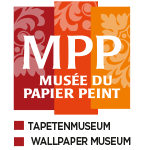
Wallpaper as Ordinary Décor and Work of Art
The Museum collection provides a broad vista of the history of wallpaper (100,000 documents), from 18th Century domino-patterns to more recent designs.
The collections from the Zuber factory and the Museum of Printed Textiles in Mulhouse, have been expanded since 1983 with the addition of thousands of other documents donated or acquired with the aid of the regional museum acquisition fund (State and Alsace Region), M2A (Mulhouse Metropolitan Area) and the Town of Rixheim.
The distinctive feature of the Museum at Rixheim is its decision to conserve all types of wallpaper, be they manufacturers’ masterpieces or a mass produced work. In fact, this décor provides an historical and sociological record giving us access to the intimacy of a home, with insights into the tastes of its successive inhabitants and their social status. On the other hand, it also reveals the history of the manufacturer that created it; that manufacturer’s commercial strategy and the technical developments which it achieved, from its inception to its closure. Ultimately, wallpaper is a decorative art which, since it sought to imitate all the others, provides an astonishing insight into the evolution of artistic styles. From the neo-classicism of the end of the 18th Century, to contemporary design, via historicism, Art Nouveau and Art Deco, wallpaper recounts the story of wall decoration over four centuries.
Eight panoramics from the Zuber factory, designed in the first half of the 19th Century, are on permanent display on the 2nd floor of the Museum. Other panoramics are kept in reserve and displayed occasionally according to the subject matter of the exhibitions.